第23章 9(1)
There is a resemblance between the osseous and the vascular systems; for each has a central part in which it begins, and each forms a continuous whole. For no bone in the body exists as a separate thing in itself, but each is either a portion of what may be considered a continuous whole, or at any rate is linked with the rest by contact and by attachments; so that nature may use adjoining bones either as though they were actually continuous and formed a single bone, or, for purposes of flexure, as though they were two and distinct. And similarly no blood-vessel has in itself a separate individuality; but they all form parts of one whole. For an isolated bone, if such there were, would in the first place be unable to perform the office for the sake of which bones exist; for, were it discontinuous and separated from the rest by a gap, it would be perfectly unable to produce either flexure or extension; nor only so, but it would actually be injurious, acting like a thorn or an arrow lodged in the flesh. Similarly if a vessel were isolated, and not continuous with the vascular centre, it would be unable to retain the blood within it in a proper state. For it is the warmth derived from this centre that hinders the blood from coagulating; indeed the blood, when withdrawn from its influence, becomes manifestly putrid. Now the centre or origin of the blood-vessels is the heart, and the centre or origin of the bones, in all animals that have bones, is what is called the chine. With this all the other bones of the body are in continuity; for it is the chine that holds together the whole length of an animal and preserves its straightness. But since it is necessary that the body of an animal shall bend during locomotion, this chine, while it is one in virtue of the continuity of its parts, yet its division into vertebrae is made to consist of many segments. It is from this chine that the bones of the limbs, in such animals as have these parts, proceed, and with it they are continuous, being fastened together by the sinews where the limbs admit of flexure, and having their extremities adapted to each other, either by the one being hollowed and the other rounded, or by both being hollowed and including between them a hucklebone, as a connecting bolt, so as to allow of flexure and extension. For without some such arrangement these movements would be utterly impossible, or at any rate would be performed with great difficulty. There are some joints, again, in which the lower end of the one bone and the upper end of the other are alike in shape. In these cases the bones are bound together by sinews, and cartilaginous pieces are interposed in the joint, to serve as a kind of padding, and prevent the two extremities from grating against each other.
Round about the bones, and attached to them by thin fibrous bands, grow the fleshy parts, for the sake of which the bones themselves exist. For just as an artist, when he is moulding an animal out of clay or other soft substance, takes first some solid body as a basis, and round this moulds the clay, so also has nature acted in fashioning the animal body out of flesh. Thus we find all the fleshy parts, with one exception, supported by bones, which serve, when the parts are organs of motion, to facilitate flexure, and, when the parts are motionless, act as a protection. The ribs, for example, which enclose the chest are intended to ensure the safety of the heart and neighbouring viscera. The exception of which mention was made is the belly. The walls of this are in all animals devoid of bones; in order that there may be no hindrance to the expansion which necessarily occurs in this part after a meal, nor, in females, any interference with the growth of the foetus, which is lodged here.